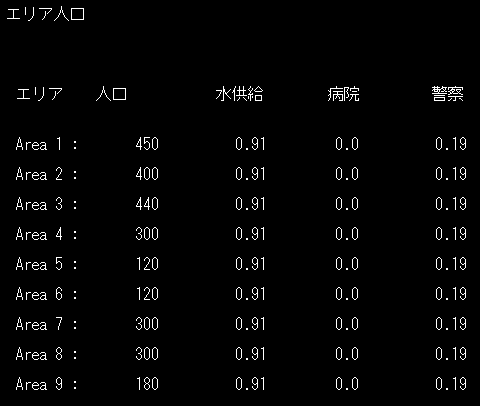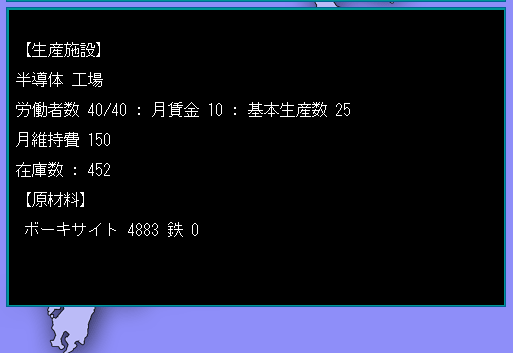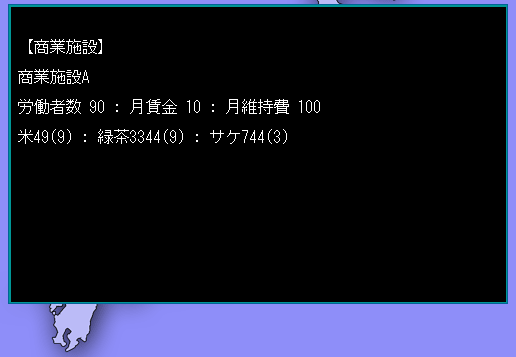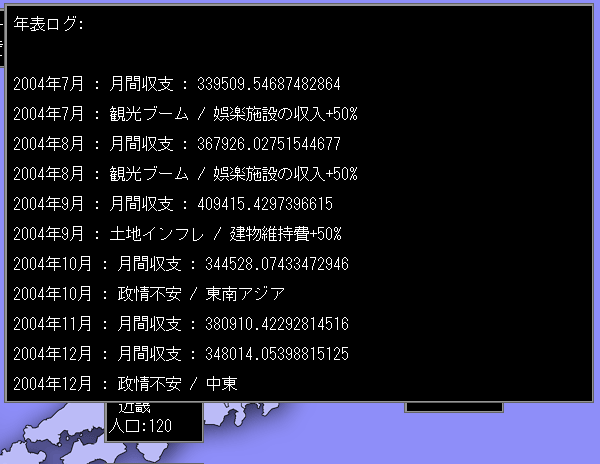ゲームの進め方 - how to play -
このゲームの目的は、スロットに建設された建物同士の相乗効果によって
一日の収益を高め、現金を増やしていくことです。
ゲーム中にctrlキーを押すと、一日が経過し、建物の維持費、労働者の賃金、
家賃などが日割りで算出され、その日の収支が画面右上に表示されます。
The purpose of this game is to use the synergy between the buildings built in the slot. The goal is to increase your daily earnings and increase your cash.
When you press ctrl during the game, a day passes, building maintenance costs, worker wages,
Rent, etc. will be calculated on a daily basis, and the balance for that day will be displayed at the top right of the screen.

また7日ごとに配送サイクルがあり、全ての建物の配送、輸出入処理が行われます。
このタイミングで産業の輸出入による貿易収支が算出されます。
There is also a delivery cycle every 7 days, and all building deliveries, imports and exports are processed.
At this point, the trade balance due to imports and exports of industries is calculated.
まず浄水施設を建設する - build water plant at first -
このゲームには住宅指数、産業指数の2つの指数が設定されています。
住宅指数:
人口に影響する係数。
浄水施設、病院など特定の建物を建設するとエリアごとに指数が増加する。
そのエリアに住宅を建設した際に、住宅に入居する人口は住宅指数に比例する。
住宅指数の初期値は0のため、初期状態で住宅だけを建設しても入居者数は0である。
産業指数:
一次産業、二次産業の産業施設の一日生産高に影響する係数。
発電所、学校など特定の建物を建設するとエリアごとに指数が増加する。
産業指数の初期値は1であり、指数が増加するとそのエリアに産業施設を建設した際に
指数に比例して生産高が増加する。
産業には労働者=人口が必要であり、住宅指数が0の場合住宅を建設しても入居者が入らず
人口は増えません。
そのためゲーム開始時にまず浄水場か病院を任意のエリアに建設する必要があります。
(この二つの建物は労働者が0でも効果を発揮します。)
病院は建設したエリアのみ住宅指数が上昇します。
浄水施設は全てのエリアの住宅指数が上昇しますが、効果が分散されるほか、
建設するスロットに水資源が必要になります。
指数はRボタンでの情報パネルで確認することができます。
パネルで住宅指数が上昇していることを確認したら、今度は住宅を建設します。
This game has two indexes: a housing index and an industrial index.
Housing index:
Coefficients affecting population.
When specific buildings such as water purification facilities and hospitals are constructed, the index increases in each area.
When a house is built in that area, the number of people living in the house is proportional to the housing index.
The initial value of the housing index is 0, so even if only housing is constructed in the initial state, the number of residents will be 0.
Industrial index:
Coefficients that affect the daily output of industrial facilities in the primary and secondary industries.
The index increases in each area when specific buildings such as power plants and schools are constructed.
The initial value of the industrial index is 1, and as the index increases, when an industrial facility is constructed in that area
Output increases in proportion to the index.
Industry requires workers = population, and if the housing index is 0, there will be no tenants even if houses are built
The population will not increase.
Therefore, at the beginning of the game, you must first build a water purification plant or hospital in any area.
(These two buildings are effective even if there are 0 workers.)
The housing index of the hospital will increase only in the area where it is built.
Water purification facilities will increase the housing index in all areas, but the effect will be dispersed, and
You will need water resources in the slot you are building.
You can check the index on the information panel by pressing the R button.
After confirming that the housing index is increasing on the panel, it's time to build a house.

住宅を建設する - build resident -
あらゆる建物は労働者を必要としますが、労働者を確保するためには同一エリアに住宅を
建設し、そのエリアの人口を増やす必要があります。
収容人数重視型
プレハブなどが該当
建設価格の割りに収容人数が多いですが、住宅品質が低いためエリアの住宅指数が
低いと入居者はなかなか増えません。
同一エリアに病院などを建設することで入居者数を底上げすることができます。
労働者確保優先型
アパート、マンションなどが該当
プレハブなどと比較すると住宅品質が高く、住宅指数が低めでもそれなりに入居者を
確保することができます。
賃料は低めのため維持費と差し引くと住宅自体での収入はあまり期待できません。
賃料重視型
マンション、高級住宅などが該当
家賃収入を重視したタイプです。
住宅品質が高く、住宅指数が低くても入居者が入りますが、最大収容人数が少ないため
労働者の確保には向いていません。
住宅の入居者数は以下のように算出されます。
見込み入居者数 = 住宅品質÷50 × (エリアの住宅指数×1000) × (政策による補正)
エリアの最大収容数を見込み入居者数が上回っている場合、住宅は定員上限まで入居する
エリアの最大収容数を見込み入居者数が下回っている場合、入居者はエリアの住宅に品質に比例して
割り当てられる。
住宅指数が1で、かつエリアの全ての住宅の品質が50の場合、そのエリアの見込み入居者数は1000人になります。
住宅政策が布告されている間は見込み入居者数に1.5倍の補正が加えられます。
Every building requires workers, but in order to secure workers, it is necessary to build houses in the same area
You need to build and increase the population of that area.
Capacity-oriented type
Applicable to prefab etc.
Although the number of people accommodated is large considering the construction price, the housing index of the area is low due to the low housing quality. If it is low, the number of residents will not increase easily.
You can increase the number of residents by building a hospital or other facility in the same area.
Priority type for securing workers
Applies to apartments, condominiums, etc.
Compared to prefabricated housing, the quality of housing is high, and even if the housing index is low, it attracts a certain number of tenants. can be secured.
The rent is low, so after deducting the maintenance costs, you can't expect much income from the house itself.
Rent-oriented type
Applies to condominiums, luxury homes, etc.
This is a type that focuses on rental income.
Even if the housing quality is high and the housing index is low, there will be tenants, but the maximum capacity is small
Not suitable for securing workers.
The number of residents in a house is calculated as follows.
Expected number of residents = Housing quality ÷ 50 × (Area housing index × 1000) × (Corrected by policy)
If the expected number of residents exceeds the maximum capacity of the area, the house will be filled to its maximum capacity
If the expected number of tenants is less than the maximum capacity of the area, tenants will be allocated to housing in the area in proportion to the quality
Assigned.
If the housing index is 1 and the quality of all housing in an area is 50, the expected number of residents in that area is 1000.
While the housing policy is being declared, a 1.5x adjustment will be made to the expected number of residents.
一次産業を建設する - build primary industry -
エリアの人口が確保できたら、次は一次産業を建設します。
一次産業には以下のようなものがあります。
[食品系]
主に商店で販売するか、そのまま輸出する。
ゲーム開始時に各スロットに資源が25%の確率で割り当てられる。
米 水田
みかん 農園
リンゴ 農園
緑茶 農園
豚肉 牧場
鶏肉 牧場
サケ 漁場
マグロ 漁場
カツオ 漁場
[資源系]
主に二次産業の原材料に使用される。
ゲーム開始時に各スロットに資源が5%の確率で割り当てられる。
ボーキサイト 鉱山
シリコン(石英) 鉱山
鉄 鉱山
銅 鉱山
原油
一次産業の建物の建設が完了すると、人口に応じて労働者が割り当てられます。
基本的に人口=労働者数であり、人口がエリアの労働上限の合計を上回っている場合は
全ての労働スロットに労働者が入り、不足している場合は均等に労働者が割り振られます。
労働者が入ると、一日ごとに建物維持費、賃金を消費し、
産業指数に応じた生産高の商品が生産されます。
商品生産高 = 基本生産数 × 最大労働人数に対する労働者数 × 賃金指数 × 産業指数 × (政策、イベントによる補正)
全ての産業には基本生産数が設定されています。建物をアップグレードすると基本生産数は増加します。
賃金指数とは、外国平均給与に対する賃金の比較であり、賃金が外国平均給与を下回った場合、比例して生産高は減少します。
逆に外国平均給与を上回っている場合、x0.4の補正を受けて差額分生産高は上昇します。
つまり賃金が外国平均給与と一致している場合が最も賃金効率が良く、それを上回っても下回っても賃金効率は低下することになります。
Once the population of the area is secured, the next step is to build primary industry.
Primary industries include the following:
[Food-related]
They are mainly sold in stores or exported as is.
At the start of the game, resources are allocated to each slot with a 25% chance.
Rice paddy
Mikan farm
Apple farm
Green tea farm
Pork ranch
Chicken ranch
Salmon fishing ground
Tuna fishing ground
Bonito fishing ground
[Resources]
Mainly used as raw material for secondary industries.
At the start of the game, resources are allocated to each slot with a 5% chance.
Bauxite mine
Quarts mine
Iron mine
Copper mine
Crude oil
Once construction of primary industry buildings is completed, workers will be allocated according to population.
Basically, population = number of workers, and if the population exceeds the total labor limit for the area
All labor slots will have workers, and if there is a shortage, workers will be distributed equally.
When workers enter, building maintenance costs and wages are consumed each day.
Goods are produced with output according to the industry index.
Product output = Basic production number × Number of workers relative to the maximum number of workers × Wage index × Industrial index × (correction due to policies and events)
All industries have a base production number. Upgrading buildings will increase the base production quantity.
The wage index is a comparison of wages against the foreign average salary; if wages fall below the foreign average salary, output will decrease proportionately.
On the other hand, if the salary is higher than the foreign average salary, the output will increase by the difference after being adjusted by x0.4.
In other words, wage efficiency is highest when wages match the average overseas salary, and wage efficiency decreases when wages are above or below that.
商品を輸出する - export product -
産業施設で商品を生産した場合、その商品は施設に在庫としてストックされます。
このままでは収入にならず、維持費と賃金の分だけ赤字になります。
そのため生産した商品は外国に輸出する必要があります。
輸出先は5カ国あるので、出来るだけ輸出価格の高い国に輸出したほうが収益が
高くなります。
輸出価格は各国で異なり、毎日-+50%の範囲で変動しています。
輸出価格はRボタンでの情報パネルで確認することができます。
When a product is produced at an industrial facility, that product is stocked as inventory at the facility.
If this continues, there will be no income, and there will be a deficit for maintenance costs and wages.
Therefore, the products produced must be exported to foreign countries.
There are 5 countries for export, so it is more profitable to export to the country with the highest export price as possible
It will be expensive.
Export prices vary from country to country and fluctuate by -+50% every day.
You can check the export price on the information panel by pressing the R button.
二次産業を建設する - build secondary industry -
二次産業はどのスロットにも建設することができますが、生産に原材料が必要になります。
商品生産1に対し、該当する原材料を各1ストックしておく必要があり、原材料が1種類でも
欠けていると生産はストップします。
原材料をストックするには2種類の方法があります。
原材料を生産している施設のスロットから配送設定を行う。
外国から輸入する
外国からは無制限に原材料を輸入できますが、輸入価格は原則輸出価格の150%のため、
コストが割高になります。
いずれの方法でも搬入は7日毎の配送サイクルで行われます。
Secondary industries can be built in any slot, but require raw materials for production.
It is necessary to stock one of each applicable raw material for each product production, and even if there is only one type of raw material
If it is missing, production will stop.
There are two ways to stock raw materials.
Configure delivery from the slot of the facility that produces the raw materials.
Import from foreign countries
Although raw materials can be imported from foreign countries without limit, the import price is generally 150% of the export price, so
The cost will be high.
In either case, deliveries are made on a 7-day delivery cycle.

半導体 工場
原材料にシリコンが必要
アルミニウム 工場
原材料にボーキサイトが必要
テレビ 工場
原材料にプラスチック、銅が必要
パソコン 工場
原材料に半導体、銅が必要
自動車 工場
原材料に製鉄、アルミニウム、銅が必要
製鉄 工場
原材料に鉄が必要
プラスチック 工場
原材料に原油が必要
Semiconductor factory
silicon (quartz) is required as a raw material
Aluminum factory
Requires bauxite as raw materials
TV factory
plastic and copper are required as raw materials
Computer factory
Semiconductor and copper are required as raw materials
Automobile factory
steel, aluminum, copper are required as raw materials
Steel factory
Iron is required as a raw material
Plastic factory
Crude oil is required as a raw material
商業施設を建設する - build commercial facilities -
商業施設はエリアの住民に商品を売る施設で、人口が多いエリアほど商品が
多く売れます。
Commercial facilities are facilities that sell products to residents in the area, and the more populated the area, the more products there are. It sells a lot.

商業施設A
米、緑茶、サケを販売
商業施設B
ミカン、豚肉、マグロ
商業施設C
リンゴ、鶏肉、カツオ
商業施設の状況は
商品名+商品在庫(一日商品需要)
で表示されます。
商業施設は施設ごとに売り物が決められており、まず商品を仕入れる必要があります。
仕入れの方法は以下の2通りです。
商品を生産している施設のスロットから配送設定を行う。
外国から輸入する
外国からは無制限に原材料を輸入できますが、輸入価格は原則輸出価格の150%のため、
コストが割高になります。
いずれの方法でも搬入は7日毎の配送サイクルで行われます。
一日経過すると施設の在庫から商品需要の分だけ商品が売れていきます。
商品在庫が需要を下回っている場合は売り上げは発生しません。
つまりなるべく商品が欠品しないほうが施設の効率は良くなります。
一日の商品需要 = 基本商品需要 × 賃金指数 × (労働者数÷100) × (エリア人口÷100) × (政策による補正)
人口は労働者数に影響するので結果的に商品需要は(労働者数が上限になるまで)人口の二乗に比例します。
内需拡大政策が布告されている間は全エリアの商品需要は2倍になります。
Commercial facility A
Selling rice, green tea, and salmon
Commercial facility B
Mandarin oranges, pork, tuna
Commercial facility C
Apple, chicken, bonito
The situation of commercial facilities
Product name + product inventory (daily product demand)
indicated by.
Each commercial facility has its own set of items for sale, so you must first purchase the products.
There are two methods of purchasing:
Configure delivery settings from the slot of the facility that produces the product.
Import from foreign countries
Although raw materials can be imported from foreign countries without limit, the import price is generally 150% of the export price, so
The cost will be high.
In either case, deliveries are made on a 7-day delivery cycle.
After one day, products will be sold from the facility's inventory in proportion to the demand for the products.
If product inventory is lower than demand, no sales will occur.
In other words, the efficiency of the facility will be better if there are no shortages of products.
Daily product demand = Basic product demand × Wage index × (Number of workers ÷ 100) × (Area population ÷ 100) × (Policy correction)
Since population affects the number of workers, the result is that demand for goods is proportional to the square of population (until the number of workers reaches an upper limit).
While the domestic demand expansion policy is being declared, the demand for goods in all areas will double.
観光施設を建設する - Build tourist facilities -
観光施設には以下の3種類があります。
輸送施設
(旅客港、鉄道駅、空港)
観光客を域外から輸送してくる施設です。
輸送施設で来訪した人数が当日の観光客数になるため、宿泊施設、娯楽施設の
上限人数を決定します。
観光業のプロセスは輸送→宿泊→娯楽施設の順になっており、後ろのプロセスの人数が
手前のプロセスの人数を超えることはありません。
つまりまず輸送施設で観光客数を集めることが重要になります。
見込み観光客数 = 全エリア人口 × 0.4 + 全ての輸送施設の(施設効果 × 労働者割合)
輸送施設には輸送能力の他、観光客数を底上げする施設効果が設定されていて、労働者数が
最大のとき施設効果は最大になります。
見込み観光客数が全エリアの輸送施設のキャパシティを上回った場合、観光客数は輸送上限で
頭打ちになります。
宿泊施設
(安ホテル、ホテル、高級ホテル)
観光客を宿泊させる施設です。
宿泊料が収益に計上されるほか、宿泊人数は娯楽施設の上限人数を決定します。
見込み宿泊者数 = 収容上限人数 × 労働者割合 × 賃金指数
観光客数(=輸送人数) を見込み宿泊者数が上回っている場合、宿泊者数は観光客数で
頭打ちになります。
宿泊収入 = 宿泊者数 × 施設効果
娯楽施設
(映画館、美術館、遊園地、ランドマーク)
観光客から施設利用収入を計上します。
利用者数は観光指数によって変動しますが、宿泊施設の利用者数が上限人数に
なります。
見込み利用者数 = 利用上限人数 × 労働者割合 × 賃金指数
宿泊客数(=輸送人数) を見込み利用者数が上回っている場合、利用者数は観光客数で
頭打ちになります。
利用収入 = 利用者数 × 施設効果 × (政策、イベントによる補正)
娯楽施設の収益は政策、イベントの影響を受けます。
観光促進の政策を布告している間は、娯楽施設での観光収入が200%になります。
娯楽施設は前提として輸送施設、宿泊施設を建設する必要がありますが、
その分利用収入が得られた場合高い収益が期待できます。
There are three types of tourist facilities:
Transportation facilities
(Passenger ports, railway stations, airports)
This is a facility that transports tourists from outside the area.
Since the number of people visiting the transportation facility will be the number of tourists on the day, the number of tourists at the accommodation and entertainment facilities will be reduced. Decide on the maximum number of people.
The process of tourism is in the order of transportation → accommodation → entertainment facilities, and the number of people in the back process is
The number of users will not exceed the number of processes in front.
In other words, it is important to first attract tourists through transportation facilities.
Expected number of tourists = total area population × 0.4 + (facility effect × worker ratio) of all transportation facilities
In addition to transportation capacity, transportation facilities have a facility effect that increases the number of tourists, and the number of workers. When it is maximum, the facility effect is maximum.
If the number of prospective tourists exceeds the capacity of transportation facilities in all areas, the number of tourists will be at the transportation limit
It will hit a plateau.
Accommodation
(cheap hotels, hotels, luxury hotels)
This is a facility that accommodates tourists.
In addition to recording room charges as revenue, the number of guests determines the maximum number of people at an entertainment facility.
Expected number of guests = Maximum number of people accommodated × Labor ratio × Wage index
If the expected number of overnight guests exceeds the number of tourists (= number of people transported), the number of overnight guests is the number of tourists
It will hit a plateau.
Accommodation income = Number of guests × Facility effect
Entertainment facilities
(Movie theaters, museums, amusement parks, landmarks)
We record facility usage income from tourists.
The number of users varies depending on the tourism index, but the number of users of the accommodation facility is the maximum number of people
Become.
Expected number of users = Maximum number of users × Labor ratio × Wage index
If the expected number of users exceeds the number of overnight guests (= number of people transported), the number of users is the number of tourists
It will hit a plateau.
Usage income = number of users × facility effect × (correction due to policies and events)
Entertainment facility revenues are affected by policies and events.
While promulgating tourism promotion policies, tourism revenue from entertainment facilities will be 200%.
As a prerequisite for recreational facilities, it is necessary to construct transportation facilities and accommodation facilities, but
If you can earn usage income from that amount, you can expect high profits.
賃金を設定する - set wages -
shiftボタンでメニュー画面を開くか、あるいはキーボード右上の1を押すことで
賃金設定のウィンドウが開きます。
賃金は職業ごとに設定可能ですが、一次産業の場合、農業は農家、鉱山は工夫など
施設の種類で一括の設定になります。
賃金は一日ごとに変動する外国平均給与と比較されており、外国平均給与を上回るか
下回るかで労働者の効果は変わって生きます。
賃金指数とは、外国平均給与に対する賃金の比較であり、賃金が外国平均給与を下回った場合、比例して労働者効果は減少します。
逆に外国平均給与を上回っている場合、x0.4の補正を受けて差額分労働者効果は上昇します。
つまり賃金が外国平均給与と一致している場合が最も賃金効率が良く、それを上回っても下回っても賃金効率は低下することになります。
Open the menu screen with the shift button or press 1 on the top right of the keyboard
The Wage Settings window opens.
Wages can be set for each occupation, but in the case of primary industries, agriculture is for farmers, mining is for ingenuity, etc.
All settings are made by facility type.
Wages are compared with the average foreign salary, which varies on a daily basis, and whether it is higher than the average foreign salary
The effectiveness of workers will change depending on whether it is below.
The wage index is a comparison of wages against the foreign average salary, and when wages fall below the foreign average salary, the worker effect decreases proportionately.
On the other hand, if the salary exceeds the foreign average salary, the worker effect increases by the difference after being adjusted by x0.4.
In other words, wage efficiency is highest when wages match the average overseas salary, and wage efficiency decreases when wages are above or below that.
政策を布告する - proclaim policy -
政策を布告することで、布告期間中に特定の効果を高めることが出来ます。
社会保障
住民+50%
生産向上
生産力+50%
輸出強化
輸出価格+30%
観光促進
娯楽施設収入+100%
内需拡大
商店の需要+200%
倹約政策
建物維持費 -50%
政策は同時に一件のみ布告できます。
By proclaiming a policy, you can increase certain effects during the proclamation period.
Social security
Residents +50%
Improved production
Productivity +50%
Strengthening exports
Export price +30%
Tourism promotion
Entertainment facility income +100%
Expansion of domestic demand
Shop demand +200%
Frugal policy
Building maintenance cost -50%
Only one policy can be declared at a time.
ログを確認する - Check the log -

時間が経過すると一ヶ月ごとに月間収支、一年ごとに年間収支がログに記載されます。
またイベントが発生した場合もログに記載されるため、まめに状況を確認することが
重要です。
As time passes, the monthly income and expenditure for each month and the annual income and expenditure for each year are recorded in the log.
Also, if an event occurs, it will be recorded in the log, so you can check the status frequently. It is important.
■ トップページに戻る / back to top page ■
